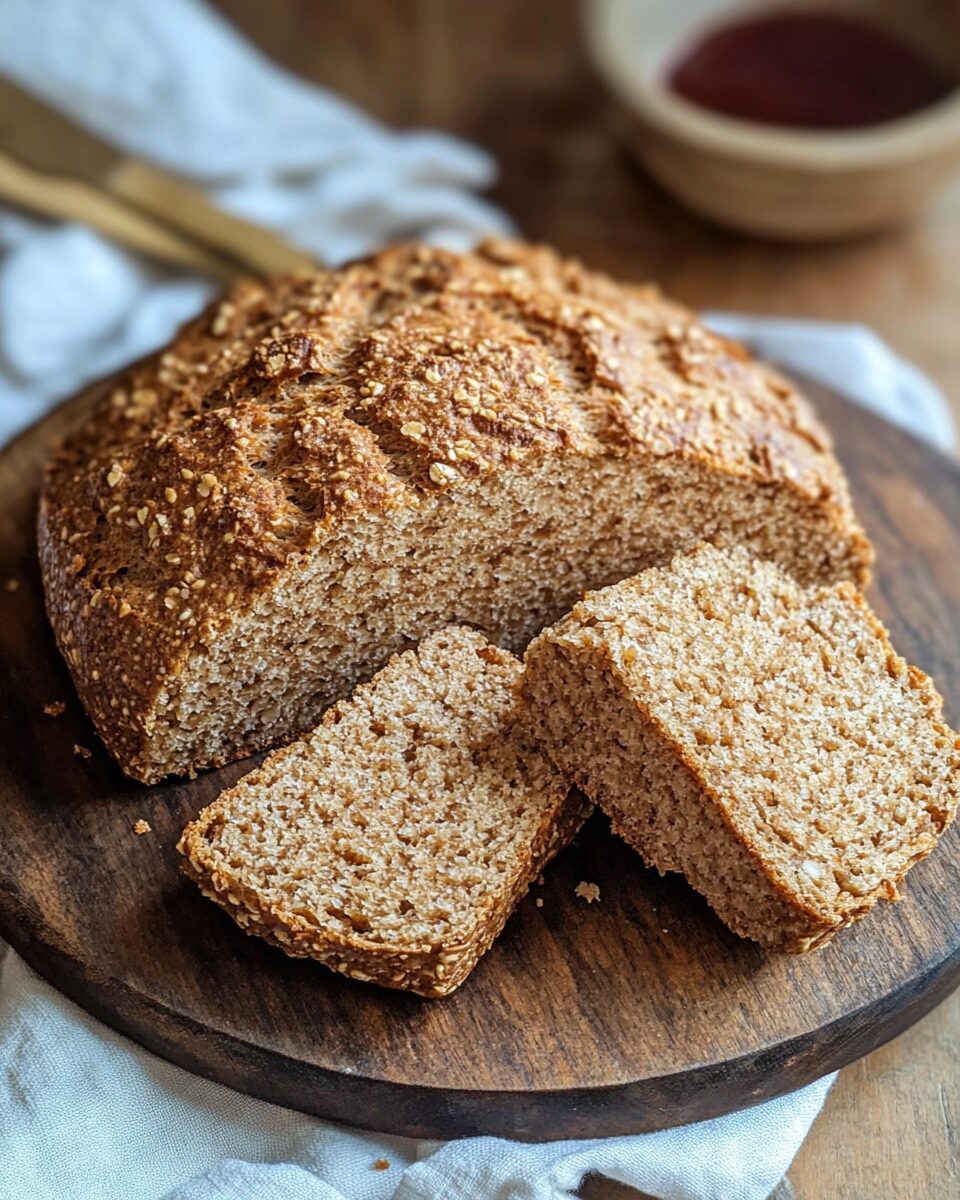Irish Brown Bread is a staple of traditional Irish cuisine, known for its hearty texture, nutty flavor, and wholesome ingredients. Made with whole wheat flour and buttermilk, this quick bread is simple to prepare and requires no yeast, making it an ideal choice for a last-minute homemade treat. The deep cross cut into the top of the dough is not just decorative—it helps the bread bake evenly and, according to Irish folklore, lets the fairies escape!
This rustic loaf is perfect for breakfast, lunch, or dinner. Serve it warm with a spread of creamy Irish butter, drizzle with honey for a touch of sweetness, or enjoy it alongside a comforting bowl of soup. Whether you’re celebrating St. Patrick’s Day or simply want to experience the charm of Irish baking, this recipe is a must-try!
Full Recipe
Ingredients:
- 3 1/2 cups whole wheat flour
- 1 cup all-purpose flour
- 1 teaspoon baking soda
- 1 teaspoon salt
- 2 tablespoons butter, softened
- 1 3/4 cups buttermilk
- 2 tablespoons honey or molasses
Directions:
- Preheat oven to 400°F (200°C). Grease and lightly flour a loaf pan or baking sheet.
- In a large mixing bowl, whisk together whole wheat flour, all-purpose flour, baking soda, and salt.
- Cut the butter into the flour mixture using your fingers or a pastry cutter until it resembles coarse crumbs.
- Stir in the buttermilk and honey (or molasses) until a sticky dough forms.
- Transfer the dough to a lightly floured surface and knead gently for about 1-2 minutes until it comes together.
- Shape the dough into a round or oval loaf and place it on the prepared baking sheet (or in a loaf pan).
- Cut a deep cross on the top of the dough using a sharp knife.
- Bake for 35-40 minutes, or until the bread is golden brown and sounds hollow when tapped on the bottom.
- Remove from the oven and let cool on a wire rack before slicing.
Prep Time: 10 minutes | Cooking Time: 40 minutes | Total Time: 50 minutes
Kcal: 180 kcal per slice | Servings: 10 slices
A Brief History of Irish Brown Bread
Irish brown bread is a staple in Irish cuisine, deeply rooted in the country’s history and culture. Unlike white bread, which was often considered a luxury, brown bread was widely consumed by the working class due to its affordability and nutritional benefits. Traditionally made with whole wheat flour, baking soda, and buttermilk, it was a simple yet wholesome bread that sustained many Irish families for centuries.
The origins of Irish brown bread date back to the early 19th century when baking soda was introduced in Ireland. Before that, most bread was made using a sourdough process, which required a long fermentation time. The addition of baking soda, combined with the naturally acidic buttermilk, allowed for a quicker leavening process, making brown bread an easy and accessible option for households across Ireland.
Why Irish Brown Bread Stands Out
One of the most distinctive features of Irish brown bread is its dense, hearty texture. Unlike its sweeter cousin, soda bread, brown bread is more robust and rich in fiber, making it a healthier alternative. It has a deep, nutty flavor that pairs well with both sweet and savory accompaniments. Whether spread with butter and jam or served alongside a steaming bowl of Irish stew, this bread is a versatile delight that suits any meal.
The bread’s deep brown color comes from whole wheat flour, which provides added nutrients, including fiber, iron, and B vitamins. Unlike highly processed white bread, which strips grains of their natural goodness, brown bread retains most of the wheat’s nutritional value, making it a favored choice for those looking to maintain a balanced diet.
Cultural Significance and Modern Adaptations
In Irish households, baking bread was more than just a daily routine—it was a cherished tradition passed down through generations. Each family had its own variation of brown bread, with some adding a touch of molasses or honey for a subtle sweetness, while others incorporated oats for added texture.
Today, Irish brown bread remains a symbol of comfort and heritage. While many modern bakers opt for store-bought varieties, nothing compares to the aroma and taste of a homemade loaf. Some contemporary adaptations of the recipe include using spelt flour, incorporating seeds such as sunflower or flax, and experimenting with dairy-free alternatives like almond or oat milk.
Health Benefits of Irish Brown Bread
- Rich in Fiber: Whole wheat flour is an excellent source of dietary fiber, which supports digestive health and promotes a feeling of fullness.
- Heart-Healthy: The high fiber content helps regulate cholesterol levels and supports cardiovascular health.
- No Yeast Needed: Unlike traditional bread that requires yeast and fermentation, Irish brown bread is a quick bread that eliminates the need for lengthy rising times.
- Natural Ingredients: Made without artificial preservatives, homemade Irish brown bread ensures you consume only wholesome, natural ingredients.
- Sustained Energy: The complex carbohydrates found in whole wheat flour provide long-lasting energy, making this bread a great option for breakfast or a midday snack.
Best Ways to Enjoy Irish Brown Bread
Irish brown bread is incredibly versatile and can be paired with a variety of foods:
- With Butter and Jam: A classic way to enjoy a warm slice of brown bread is with a generous spread of butter and homemade jam.
- As a Side for Soups and Stews: The dense texture of brown bread makes it perfect for dipping into hearty soups like potato leek soup or a rich Irish stew.
- With Smoked Salmon and Cream Cheese: A popular Irish breakfast option, smoked salmon with a spread of cream cheese on brown bread is a true delicacy.
- With Cheddar and Chutney: Pairing brown bread with sharp Irish cheddar and a dollop of chutney makes for an irresistible snack or appetizer.
- Toasted with Honey: A drizzle of honey on a warm slice of brown bread enhances its natural nuttiness and provides a touch of sweetness.
Tips for Perfecting Irish Brown Bread
- Use Fresh Ingredients: Whole wheat flour can go rancid over time, so make sure to use fresh flour for the best flavor.
- Don’t Overwork the Dough: Kneading the dough too much can make the bread tough instead of tender. Mix until just combined.
- Score the Dough: Cutting a deep cross into the top of the dough allows for even baking and helps the bread rise properly.
- Bake at the Right Temperature: A preheated oven at 400°F (200°C) ensures a perfectly crisp crust and evenly baked interior.
- Let it Cool Completely: While it’s tempting to slice into fresh bread right away, allowing it to cool prevents it from becoming gummy inside.
Conclusion
Irish brown bread is more than just a recipe; it is a piece of Ireland’s rich culinary history. Its hearty texture, simple ingredients, and deep flavor make it a cherished staple in Irish homes and beyond. Whether enjoyed as a humble breakfast with butter or as an accompaniment to a warm, comforting meal, this bread embodies the essence of tradition and sustenance.
For those who appreciate homemade, nutritious foods, Irish brown bread is a must-try. Its ease of preparation, health benefits, and delicious taste make it a worthy addition to any kitchen. If you’re looking to bring a touch of Ireland into your home, baking a loaf of this traditional bread is a great place to start.






